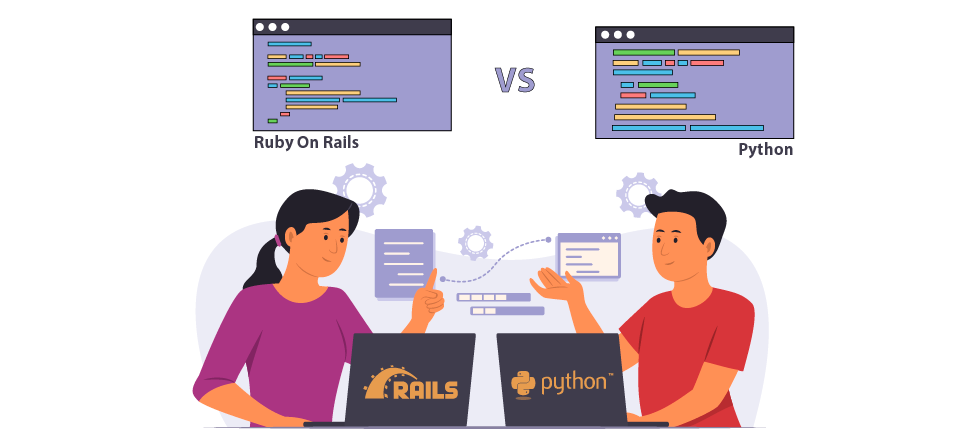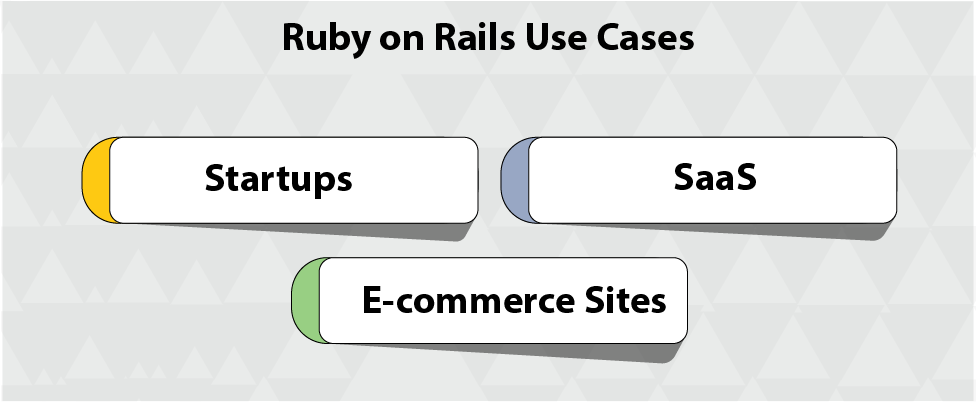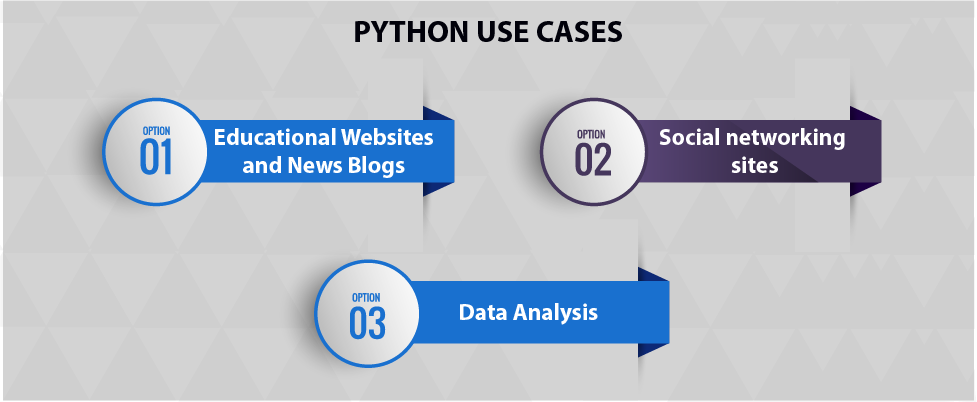Table of Contents
ToggleIntroduction
Python and Ruby on Rails (RoR) are dynamically typed languages that offer great debugging methodologies and readable syntax. Both languages assist developers in enhancing productivity as well as collaboration. However, Python is an open-source programming language, and Ruby on Rails is a framework for Ruby used for backend development. Similarly, Python also provides its own frameworks, Django and Flask. These two languages are worlds apart in terms of design philosophy and usage. In this blog, we will explore the key differences between these two languages. So, without further ado, let’s go!
Ruby on Rails and Python in Brief
Developed by David Heinemeier in 2004, Rails is a full-stack framework for Ruby. It provides pre-written code for common tasks and a structure for Ruby developers to develop web apps. During its inception, it quickly grabbed the attention of software developers for its fast speed and ease of web development. It follows the two fundamental principles: don’t repeat yourself (DRY) and convention over configuration (COC). DRY promotes clear and concise code with fewer bugs, and COC provides all the necessary configurations by default. This makes web development easier and more productive. Over the years, RoR has significantly improved and emerged as one of the most popular frameworks.
Python’s journey dates back to the late 1980s and early 1990s, but it became widely popular in 2010. Its emphasis on code readability and simplicity skyrocketed Python’s popularity, making it a top choice among both experienced and beginners alike. Now, it is widely used in various domains like machine learning, artificial intelligence, data analysis, visualization, and web development.

Don't miss out on your chance to work with the best
Apply for top global job opportunities today!
Python vs. Ruby on Rails: Comparison of Features
Python’s rich ecosystem of frameworks has largely contributed to its immense popularity in web development. Whereas Ruby on Rail stands tall with a reliable base and continuous improvements. Let’s have a look at the features of Python and RoR:

Rapid development: Python frameworks are equipped with built-in libraries and tools that speed up the development process. The most popular Python frameworks are Django, Flask, and Pyramid, which enables easier database integration, URL routing, and form handling. This, in turn, provides developers with enough time to fully focus on the application’s core logic, promote quicker development cycles, and reduce time-to-market for web applications.
Python is best for both developing small web applications and large-scale systems. It provides all the necessary tools to create a feature-rich web application. Some of the applications of Python programming are Instagram, Netflix, SpaceX, and Spotify. Its adaptability and versatile language enable it to be used in various domains, strengthening its position as a go-to language for web development. Whereas Ruby on Rails provides the perfect balance between rapid development and a focus on quality and security.
Similarly, Ruby on Rails also promotes rapid development cycles and faster prototyping with its minimal code and high readability. Its cleaner code and extensive library of over 170,000 gems simplify web development. With tools like RSpec, developers can build bug-free applications and launch the product faster while maintaining high readability and maintainability.
Scalability: When it comes to development, scalability is crucial since web applications need to handle loads over time. Python frameworks offer the best scalability. Plus, its modular architecture allows developers to scale the application either horizontally or vertically, which is one of the added advantages of Python. Almost all the Python frameworks support asynchronous programming, which is ideal for responding to concurrent requests efficiently.
On the contrary, Ruby on Rails also provides high scalability, which is why most popular sites like Airbnb, GitHub, and Shopify use Rails. Some of the features that contribute to rapid development for RoR are cache, asynchronous processing, and horizontal scaling. This allows Rails developers to scale to accommodate growing user bases and traffic loads. However, the thriving community releases performance optimizations and scalability enhancements regularly to maintain the scalability of Rails.
Security: Another factor that is a primary concern while developing web apps is security. Python frameworks come with security features and best practices, such as protection against SQL injection, cross-site scripting (XSS), and cross-site request forgery (CSRF). It also offers additional built-in features like Python frameworks that incorporate security features and best practices, such as protection against SQL injection, cross-site scripting (XSS), and cross-site request forgery (CSRF). This prevents the risk of vulnerability.
In contrast, Ruby on Rails framework prioritizes security and encourages the best secure coding practices. Its security features include cross-site scripting (XSS), cross-site request forgery (CSRF), SQL injection, authentication, authorization, and data validation. Thus, Rail’s developers can effectively build secure web applications without worrying about common vulnerabilities.
Community and Ecosystem: Python has a mature and active community of developers. Its community contributes to its frameworks and offers documentation, tutorials, and resources. This is beneficial for novices who are just starting out in web development and for experienced developers who need any help and guidance. This makes learning easy for our development. Also, the vast community regularly updates and enhances frameworks to keep them up-to-date and secure.
Alternatively, Ruby on Rails framework also has a vibrant and supportive community that provides all the necessary resources, documentation, tutorials, forums, and libraries. By going through developers, they can troubleshoot issues and assist in the web development journey. In addition, the RubyGems repository has a collection of functionalities that allow easy integration of third- parties into their applications. Besides, its community provides continuous improvement to ensure the framework remains relevant and stays updated with the evolving trends in technology.
Must Read: WHAT IS RUBY ON RAILS? WHAT IS IT USED FOR?
Using Ruby on Rails in Web Development
RoR’s intuitive and easy-to-understand syntax allows for fast creation of a web application. It can easily integrate with front-end frameworks like React, Vue, and Angular. This allows for the development of scalable web applications.

- Startups: Ruby on Rails is best for startups due to rapid prototypes and MVP development. Famous platforms like GitHub, Twitter, Airbnb, and Dribbble were built using Ruby on Rails.
- SaaS: Ruby on Rails guarantees the safety of your SaaS product. It provides all the security features, like authentication, encryption libraries, skipping forgery requests, and strong parameter usage. Some of the well-known SaaS apps built using Ruby on Rails are Basecamp, Zendesk, and GitHub.
- E-commerce Sites: Using the Gems, developers can add any features and payment gateways to their e-commerce projects. Also, with the robust security feature, developers can easily implement secure protection of payment data and personal information of both buyers and sellers to build trust in the platform. Some of the popular platforms that use Rails are Shopify, Fiverr, Groupon, and Etsy.
Using Python in Web Development
Python is one of the most popular programming languages widely used in web development. Frameworks like Django, Flask, Pyramid, and Tornado provide developers with ready-made tools to build web applications for both small and large applications. This simplifies the development process and increases efficiency.

- Educational Websites and News Blogs: Python’s ability to quickly process and display a large amount of textual information means it can create web applications like online course platforms, websites for educational institutions, and news blogs.
- Social networking sites: Due to its powerful image and audio and video data libraries, it can also be used to create social networking sites like Instagram and Pinterest.
- Data Analysis: With libraries like BeautifulSoup, Scrapy, and Requests, developers can process data collection and information analysis.
Ruby on Rails vs. Python: Key Differences
| Factors | Ruby on Rails | Python |
|---|---|---|
| Coding Approach | Promotes a creative style of coding. | Follows a conservative style of coding. |
| Built-in Class | Developers cannot modify or alter the built-in class. | It allows developers to modify the built-in class. |
| Main Fields | Used for functional programming and web development. | Due to its vast library of data science, it is mainly used for scientific and academic programming. |
| Switch -Case Statements | Supports switch-case statements | Its does not support the switch-case statements |
| Updates | It updates regularly. | It has fewer updates. |
| Mixins | Support for various inheritances enables developers to use mixins. | It does not support inheritance, so mixins can’t be used. |
| Flexibility | It has more than one way of performing any task; therefore, it is more flexible. | It has only one way to perform a task, making it comparatively less flexible. |
| Primitive Datatypes | There is no concept of primitive data types; it treats everything as an object. | It follows the concept of both primitive data types and objects. |
| Use cases | Widely used for complex and high-traffic applications. | Commonly used in big data, scientific calculations, math, and data science. |
Ruby on Rails vs Python: Which Language is the Best for your Project in 2024?
Ruby on Rails and Python offer scalability for web development projects. However, Python emerges as a versatile and easy-to-learn language, whereas Ruby on Rails framework, on the other hand, is best for rapid web app development and quite popular for elegant syntax and efficiency. Well, both languages have a large active community and the best features to help developers in their web development journey, so it’s hard to precisely pick one and say it is superior to another. because the language you choose should align with the project preferences and better suit your team. You can choose Python over Ruby on Rails if your project requires data computing and processing tasks. With Python, you can incorporate machine learning algorithms into current solutions for automating DevOps practices within projects. However, you can pick Ruby on Rails over Python for quick prototyping, high cost-efficiency for commercial projects, and full-stack development.
Rails has a good community, and they are embracing new trends and developments. Lastly, Python seamlessly handles big data, mathematical sequences, and scientific operations with heavy amounts of data and processes them. Ruby on Rails is best for implementing web applications with high-traffic and complex websites. Therefore, Python is best for both developing small web applications and large-scale systems. It provides all the necessary tools to create a feature-rich web application. Its adaptability and versatile language enable it to be used in various domains, strengthening its position as a go-to language for web development. Ruby on Rails provides the perfect balance between rapid development and a focus on quality and security. If you’re a skilled developer seeking opportunities with top global companies, then sign up with Olibr.
Take control of your career and land your dream job
Sign up with us now and start applying for the best opportunities!

FAQs
Ruby on Rails is better for web development projects because it is best for fast prototyping and faster time-to-market. Python, on the other hand, is a preferred choice for data science, machine learning, and data analysis projects.
Ruby on Rails is a backend framework and is also used for full-stack development.
Python syntax is popular for simple English-like languages. Whereas Ruby on Rails is more expressive and flexible.
Both Python and Ruby on Rails are object-oriented, simple to use, and have readable syntax. However, their use cases and project preferences are different.
Ruby on Rails is a backend framework but sometimes is used for full-stack development.
It is the tool that allows users to write, compile, and execute Ruby code directly within their web browsers. Some of the online Ruby compilers are Repl.it, Ideone, and GDB Online Debugger.

